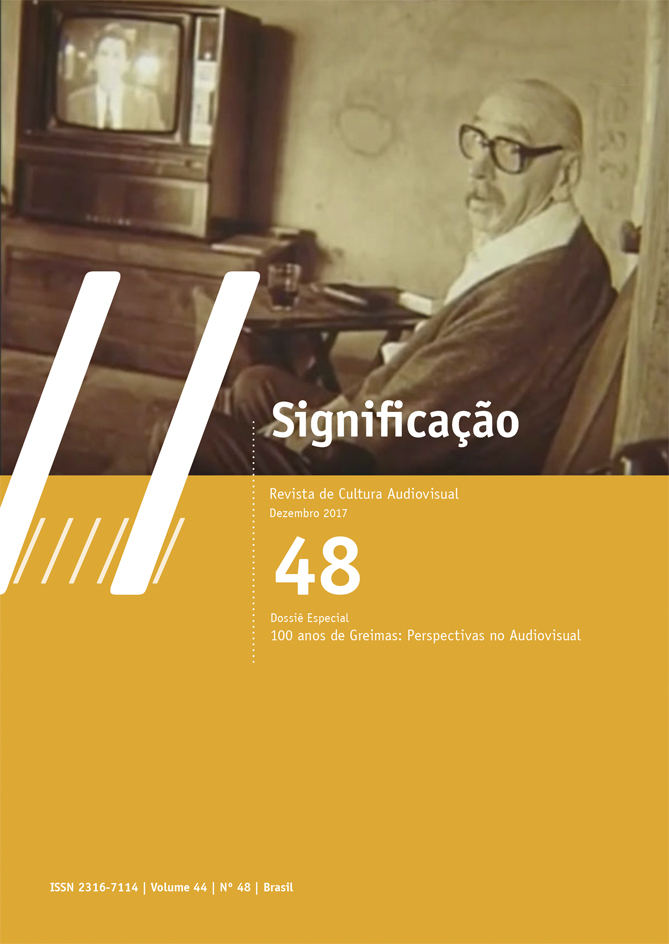Intentionality of expressive forms: style and method in Bordwell and Baxandall
DOI:
https://doi.org/10.11606/issn.2316-7114.sig.2017.131149Keywords:
style, method, Bordwell, Baxandall.Abstract
In order to encourage the appropriation among researchers of different audiovisual productions, this paper brings together the methodological resources used by Bordwell and Baxandall in the analysis of stylistic issues in two types of artistical productions: movies and paintings. The work identifies connecting points between both authors and shows how they complement each other. Among them are the development of analysis focused on the expressive forms of their respective artistic works, the use of the paradigm problem/solution, the refusal of universalizing theories, an attentive historical perspective, and the concern not to impose method over the artistic production investigated, respecting the modes of composition of each work.
Downloads
References
ANEAS, T. G. Estilo e autoria no campo do filme publicitário: os casos de “cachorro-peixe” e “últimos desejos da kombi”, da Almapbbdo. 2016. 383 f. Tese (Doutorado em Comunicação) – Universidade Federal da Bahia, Salvador, 2016. Disponível em: <https://goo.gl/x7JfdQ>. Acesso em: 27 jul. 2017.
BAXANDALL, M. O olhar renascente: pintura e experiência social na Itália da renascença. Rio de Janeiro: Paz e Terra, 1991.
______. Padrões de intenção: a explicação histórica dos quadros. São Paulo: Companhia das Letras, 2006.
BORDWELL, D. “O cinema clássico hollywoodiano: normas e princípios narrativos”. In: RAMOS, F. P. (Org.). Teoria contemporânea do cinema: documentário e narratividade ficcional. São Paulo: Senac, 2005. p. 277-301. v. 2.
______. Figuras traçadas na luz: a encenação no cinema. Campinas: Papirus, 2008.
______. Sobre a história do estilo cinematográfico. Campinas: Editora da Unicamp, 2013.
FONSECA, D. G. D. Subversão em três quadros: padrões de intenção na obra de Laerte Coutinho. 2013. 126 f. Dissertação (Mestrado em Comunicação) – Universidade Federal de Pernambuco, Recife, 2013. Disponível em: <https://goo.gl/iGUkvo>. Acesso em 15 ago. 2016.
MAUÉS, J. P. Chang Cheh e o cinema da força: estudo estilístico a partir de dez filmes do diretor. 2013. 198 f. Dissertação (Mestrado em Multimeios) – Universidade Estadual de Campinas, Campinas, 2013. Disponível em: <https://goo.gl/bU2MVj>. Acesso em 26 jul. 2017.
Downloads
Published
Issue
Section
License
Copyright (c) 2017 Tess Chamusca Pirajá

This work is licensed under a Creative Commons Attribution-NonCommercial 4.0 International License.
Authors who publish in this journal must agree with the following terms:
- Authors keep their copyrights and grant the journal first time publication rights, having their articles simultaneously licensed under the Creative Commons Attribution License, which allows sharing texts with authorship recognition and first publication on this journal for non-commercial purposes.
- Authors are allowed to make additional contracts, for a non-exclusive distribution of the article’s version published on this journal (e.g.: publishing in institutional repositories of articles or as a book chapter), with authorship recognition and first publication on this journal.
















